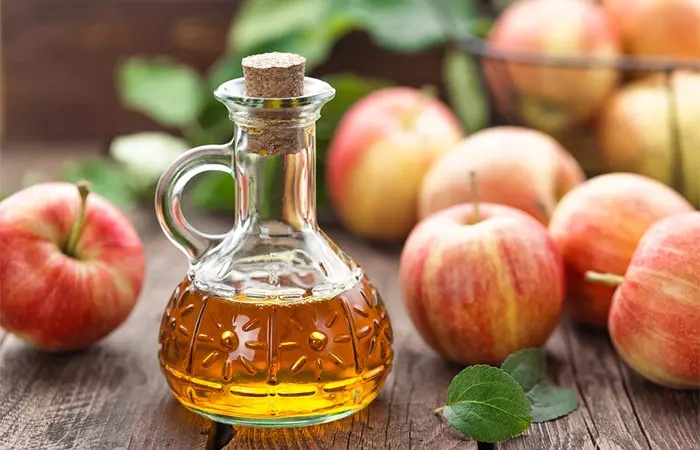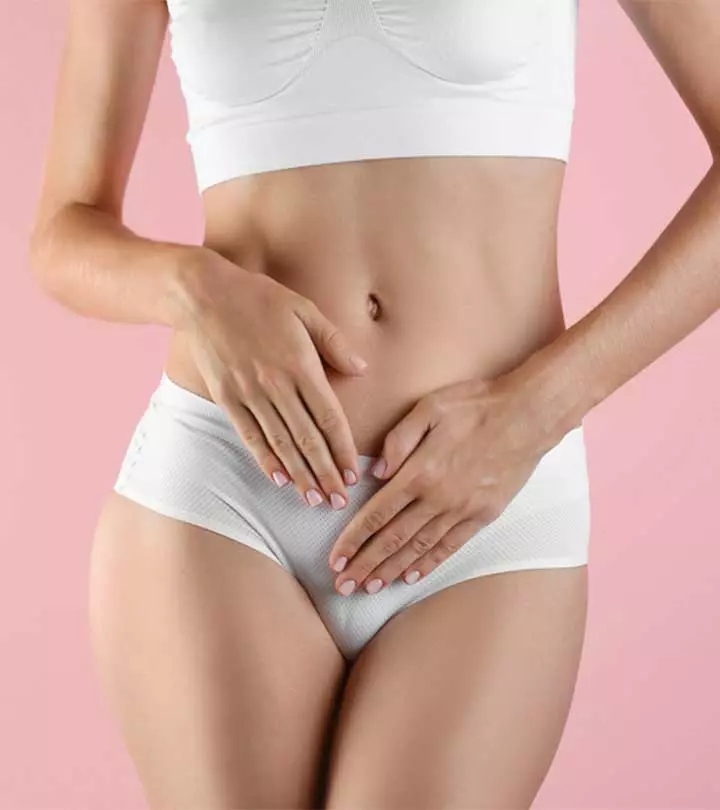What Causes Skin Tags? How Do You Remove Them?
Everything you need to know about dealing with annoying, protruding skin tissues

Image: Shutterstock
Are you bothered by the skin tags that are hanging from your skin? Skin tags are tiny growths that are common and harmless. However, they can be unappealing to look at. Skin tags are commonly found in the skin folds, like the neck, armpit, groin, and under the breasts. But, do you know what causes skin tags? This article provides all the answers about skin tags, their appearance, causes, symptoms, and treatment. Keep reading!
In This Article
What Are Skin Tags?
Skin tags, also known as fibroepithelial polyps or acrochordons, are non-cancerous and painless growths on the skin. Both men and women can get them. Almost 50-60% of adults develop skin tags in their lifetime. The chances of a skin tag forming increase after the age of 40 (1).
Skin tags can grow anywhere on the body. However, they are commonly found in the folds of the skin, like the neck, armpit, groin, and under the breasts.
They often occur in the areas of friction. They grow up to 5 mm in size. In rare cases, they can grow up to 1-2 cm.
 Trivia
TriviaIdentifying a skin tag makes it easier to figure out the best procedure for its removal. Let us find out what they look like.
Key Takeaways
- Skin tags are non-malignant growths commonly found in armpits, under the breasts, neck, and groin.
- Obesity, hormonal imbalances, diabetes, and genetics are a few factors linked to skin tags’ growth.
- You can opt for medical procedures such as cryotherapy or ligation to remove skin tags.
- If you want to go for natural remedies, you can use tea tree oil or iodine.
- Consult a doctor if your skin tag causes pain or discomfort due to the constant friction.
How Does A Skin Tag Look?

A skin tag hangs off the skin by a small stalk. It is round and soft, and it is usually the color of your skin or hyperpigmented. The surface of the skin tag may be smooth and irregular in appearance. Most skin tags or soft fibromas are painless and cause no adverse effects. In some cases, they may get sore and bleed due to rubbing against clothing or jewelry.
Small skin tags are up to 1 to 2 mm in width and height. Mid-sized are 5 mm long and 2 mm wide. Large skin tags may appear bag-like. You may also experience dry skin in the surrounding area. Skin tags can commonly be found on the neck, armpits, and groin, and in some cases, you may even see a skin tag on lips, though this is less common.
Skin tags can form due to various reasons like obesity, diabetes, genetics, etc. Read on to know what causes the development of skin tags.
What Causes Skin Tags?

Though the exact cause of skin tags is unknown, they are associated with (1):
- Abnormal cholesterol levels
- Type 2 diabetes
- Cardiovascular disease
- Obesity or being overweight
- Genetic factors
- Frequent skin irritation
- Loss of skin elasticity
- Hormonal imbalances
Also, some studies link certain viruses with skin tags. According to a 2008 study, there is a correlation between human papillomavirus and skin tags (2).
Insulin resistance may also be a cause of skin tags. A 2010 study observed a strong association between insulin resistance and skin tags (3).
Risk factors of skin tags include:

- Being overweight or obese
- Pregnancy or hormonal changes
- Family members who have skin tags
- Insulin resistance or type 2 diabetes
- Human papillomavirus infection
 Trivia
TriviaSince a skin tag is associated with these issues, you may need to visit a doctor for a brief evaluation. Keep reading to know more about skin tag diagnosis.
Diagnosis Of Skin Tag

Your doctor may ask about your medical history and conduct a physical examination to check if it is a skin tag or some other type of skin growth. For obese patients, the doctor may record their BMI (Body Mass Index). The doctor may also check total cholesterol and LDL (low-density lipoprotein) serum levels before suggesting treatment (4).
There are both medical and over-the-counter dermatological treatments available for skin tag removal. Keep reading to learn how to get rid of skin tags.
How To Treat Skin Tags
There are some over-the-counter products available that claim to remove skin tags. However, their efficacy is debatable and there is a risk of scarring. Your best bet to remove a skin tag is by medical intervention by a certified dermatologist. The doctor may use the following methods:
- Cryotherapy, which involves freezing the skin tag with liquid nitrogen.
- Surgical removal with scissors or scalpel.
- Burning off the skin tag with high-frequency electrical energy.
- Ligation, which involves tying it off with surgical thread to cut off its blood flow.
Some patients may require topical application of an anesthetic to ease the pain. The tiny wound caused by the excision will heal on its own.
Removing skin tags at home is not usually recommended as it poses the risk of infection and injury. But if you are determined to try to remove these skin growths on your own, try some of these home remedies for skin tags.
Home Remedies To Remove Skin Tags
There are many home remedies available for removing skin tags, but they are not backed by research. Some of them are:
1. Apple Cider Vinegar

1. Soak a cotton ball in apple cider vinegar.
2. Place it on the skin tag and secure it with a bandage. Leave it on for 30 minutes.
3. Wash the area with mild soap and lukewarm water and pat it dry.
4. Follow this remedy twice a day to see the results.
It can take up to 2 to 3 weeks to break down the skin tag with this remedy.
Apple cider vinegar for skin tag is loved by many skin care enthusiasts. For example, a blogger shares their experience with it saying, “I had to use Apple cider vinegar to finish the job. Skin tag turned black and fell off in about 3-5 days with no bleeding and no scarring (i).”
2. Tea Tree Oil
1. Wash the affected area and apply some tea tree oil to the skin tag with a cotton swab.
2. Secure a bandage on top of it and leave it on for 10-15 minutes.
3. Take off the bandage and clean the area with lukewarm water.
It may take a few weeks for the tag to fall off with this remedy.
3. Iodine
1. First, apply petroleum jelly to protect the skin surrounding the tag.
2. Apply iodine on the skin tag and cover it with a bandage. Wait till the iodine dries completely.
You may repeat this remedy twice a day until the tag drops off.
4. Vitamin E
- Apply liquid vitamin E to the skin tag.
- Massage the liquid over the tag and the surrounding area.
- Repeat this procedure twice a day until the tag falls off.
5. Banana Peel

- Cut a small piece of banana peel.
- Place it directly over the skin tag.
- Secure it with a bandage or gauze.
- Leave it on overnight and repeat this every night until the tag drops off.
6. Garlic

- Remove the peel of a garlic clove.
- Crush the garlic clove.
- Apply the crushed garlic to the skin tag.
- Cover the area with a bandage.
- Leave it on overnight.
- Clean the area in the morning.
- Repeat this until the skin tag shrinks and falls off.
Though it is not a good idea to remove skin tags at home, many people opt for it. Also, there are chances of the skin tag forming again. To prevent a recurrence, you may follow a few tips. Check them out in the next section.
How To Prevent Skin Tags
Since the cause of skin tags is not clear, there are no specific prevention tips that you can follow to prevent this cosmetic concern. However, you may consider following a healthy lifestyle to prevent them. Dr. Michael Newman, a board-certified plastic surgeon, says, “Because skin tags are more common in overweight or obese persons, decreasing weight may help prevent new growths. Avoid wearing clothes and jewelry that are too tight or rub against your skin to help reduce friction.”
Worried about the skin tags you have begun to notice on your body. Read on to find out when you should consult a doctor.
When Should You See A Doctor?
According to Dr. Newman, “You may visit a doctor if the color of the skin tag changes or you experience any discomfort.”
Skin tags may cause irritation due to skin, dress, or jewelry rubbing against them repeatedly. In some cases, genital skin tags may also form, which can be particularly bothersome due to their sensitive location. Consult your doctor to understand the best skin tag removal options. It is safe to remove them through medical procedures. Dr. Emily Wood, a board-certified dermatologist, says, “Home remedies often involve snipping the lesions with small scissors. It can be anxiety-provoking for patients to treat their own skin tags, so I recommend seeing a board-certified dermatologist to decide which treatment method is most appropriate for your skin type.”
A skin tag is a benign lesion. But, sometimes, other skin conditions like warts and moles resemble skin tags, and some of them may be skin cancers. So, it is best to have it examined by a doctor who specializes in dermatology to avoid complications from these skin lesions.
Frequently Asked Questions
Do skin tags grow back?
No, skin tags do not grow back after removal. However, multiple skin tags may develop in the same region of the body.
Does eating too much sugar cause skin tags?
Skin tags have been associated with high blood sugar levels in the body (5). Eating too much sugar can contribute to spikes in blood sugar levels in individuals with insulin resistance and may lead to skin tags. However, more research is needed to understand the mechanisms by which insulin resistance and skin tag formation are connected.
Can baking soda remove skin tags?
Anecdotal evidence suggests that baking soda applied as a paste on skin tags may help remove them. However, there is no scientific evidence regarding the safety and efficacy of this skin tag removal method.
Do skin tags spread?
No, skin tags do not spread from one individual to another or from one part of the body to another. However, friction in skin folds and other factors may lead to multiple skin tags on different parts of the body in individuals prone to developing skin tags.
What are the differences between skin tags, warts, and moles?
Skin tags are soft, small growths often hanging on a stalk, warts are rough and caused by a virus, and moles are pigmented skin spots that can be flat or raised. Each has distinct causes and textures.
The Bottom Line
Skin tags are common cutaneous growths. They are usually benign by nature and may not be a cause for concern. But people remove these skin abnormalities because of their unpleasant appearance. The cause of the benign tumors or skin tags is unknown. Obesity, diabetes, human papillomavirus infection, and hormonal imbalances could be some reasons for skin tag formation. There are both medical and over-the-counter treatments available for their removal. It is best to consult your doctor to diagnose any skin tags and get them medically removed.
Illustration: Skin Tags: Causes Appearance And Removal

Image: Stable Diffusion/StyleCraze Design Team
Learn about skin tags – what they are, how to identify them, and how to treat them. Check out this video and get the facts and advice you need to keep your skin healthy.
Personal Experience: Source
StyleCraze's articles are interwoven with authentic personal narratives that provide depth and resonance to our content. Below are the sources of the personal accounts referenced in this article.
i. At home skin tag removal experiment with Apple Cider Vinegarhttps://dailywanderlust.wordpress.com/2012/05/02/at-home-skin-tag-removal-experiment-with-apple-cider-vinegar/
References
Articles on StyleCraze are backed by verified information from peer-reviewed and academic research papers, reputed organizations, research institutions, and medical associations to ensure accuracy and relevance. Read our editorial policy to learn more.
- Skin Tags
https://www.ncbi.nlm.nih.gov/books/NBK547724/ - Human Papillomavirus And Skin Tags: Is There Any Association?
https://ijdvl.com/human-papillomavirus-and-skin-tags-is-there-any-association/ - Association Between Skin Tags And Insulin Resistance
https://www.scielo.br/j/abd/a/CqSVYj6c7cXhRwVvgmvDppx/?lang=en - Metabolic Associations With Skin Tags
https://www.researchgate.net/publication/296666477_Metabolic_Associations_with_Skin_Tags - SKIN TAGS IN TYPE 2 DIABETES MELLITUS: A VALUABLE MARKER
https://www.researchgate.net/publication/340170105_SKIN_TAGS_IN_TYPE_2_DIABETES_MELLITUS_A_VALUABLE_MARKER
Read full bio of Dr. Sruthi Alla
Read full bio of Swathi E
Read full bio of Anjali Sayee
Read full bio of Monomita Chakraborty



























Community Experiences
Join the conversation and become a part of our empowering community! Share your stories, experiences, and insights to connect with other beauty, lifestyle, and health enthusiasts.